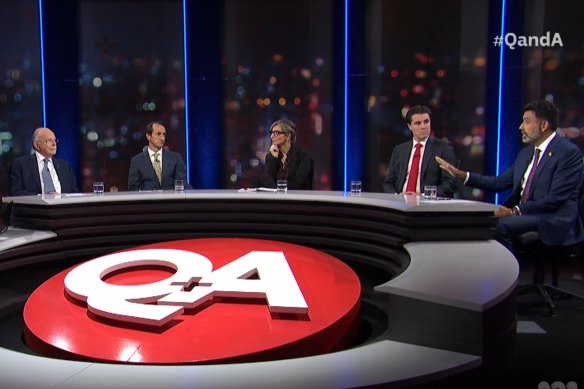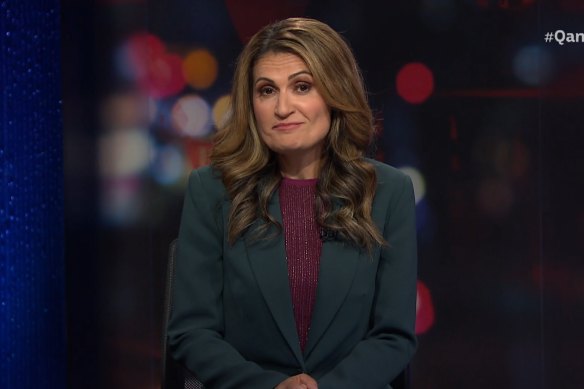Save articles for later
Add articles to your saved list and come back to them any time.
The ABC’s unusual decision to film Monday night’s episode of Q+A without a live studio audience was prompted by safety concerns following angry clashes between pro-Palestine and pro-Israel protesters in Caulfield last week.
The invitation to be part of the studio audience and to put questions directly to panellists, particularly politicians, is a key attribute of the long-running current affairs discussion program. However, an ABC source, speaking on background because they were not authorised to comment publicly, said management had concerns about the feasibility of hosting a crowd for an episode dedicated to the October 7 attack on Israel by Hamas and Israel’s bombardment of Gaza even before the protest on Friday.
The panel: Mark Leibler (left); Dave Sharma; Francesca Albanese; Tim Watts; and Nasser Mashni.Credit:
But after a burger shop in Caulfield, owned by a prominent Palestinian activist, was burned down – prompting a pro-Palestine rally nearby, which was met by pro-Israel counterprotesters – ABC management determined the risk of a live audience outweighed the benefits.
Host Patricia Karvelas addressed the issue in her introduction to the show on Monday night. Noting that the “difficult and sensitive discussion” would be conducted without a live audience, she said: “We believe in your right to ask questions, and that is a right we will always defend.”
Hinting at the tensions between the ambitions of the show generally and the reality of this particular episode, she noted that questions had been submitted via video link, adding: “We will conduct a robust, healthy and respectful debate. Without hearing from each other, we are weaker.”
A live studio audience has been a key element of the program since its launch in 2009, though COVID-19 did force it to move for a period to an audience-free model.
Host Patricia Karvelas addresses the unusual absence of a live studio audience.Credit:
“Q+A provides a rare opportunity for Australian citizens to directly question and hold to account politicians and key opinion leaders in a national public forum,” the show’s website declares. “Q+A is broadcast live so that not only the studio audience but also the wider audience can get involved.”
The significance of an episode being broadcast without a live audience in non-pandemic conditions was also addressed by panellist Tim Watts, the assistant minister for foreign affairs.
“It’s worth reflecting on where we’re sitting now,” he said late in the episode. “There’s no audience out here. There’s a very significant police contingent out the front of the public broadcaster in Australia.”
He added that it was the first time that he had seen security deployed outside the broadcaster’s offices in such a manner. “It’s deeply concerning that this is the way we have to talk about this issue.”
Noting that “what happened in Caulfield was abhorrent and should never happen again”, Watts said Australians from all backgrounds have “got to be able to have better conversations about things that we disagree on … we’ve got to get better at listening, not just listening to get your next point for outrage … but listening with curiosity, not judgment. And this is something that I think we need to model as leaders, not just political leaders, but faith leaders, civil society leaders.”
Though it marked an unwelcome departure from its own model, the absence of a live audience on Monday made little impact on the audience watching at home. Overnight figures from ratings agency OzTam show the program was watched by 209,000 viewers in the metro capital cities, and 298,000 nationally, in line with its performance over the last month or so.
Contact the author at [email protected], follow him on Facebook at karlquinnjournalist and on Twitter @karlkwin, and read more of his work here.
Find out the next TV, streaming series and movies to add to your must-sees. Get The Watchlist delivered every Thursday.
Most Viewed in Culture
From our partners
Source: Read Full Article


